check engine light RENAULT TWINGO 2009 2.G Chasiss ESP Workshop Manual
[x] Cancel search | Manufacturer: RENAULT, Model Year: 2009, Model line: TWINGO, Model: RENAULT TWINGO 2009 2.GPages: 101
Page 12 of 101
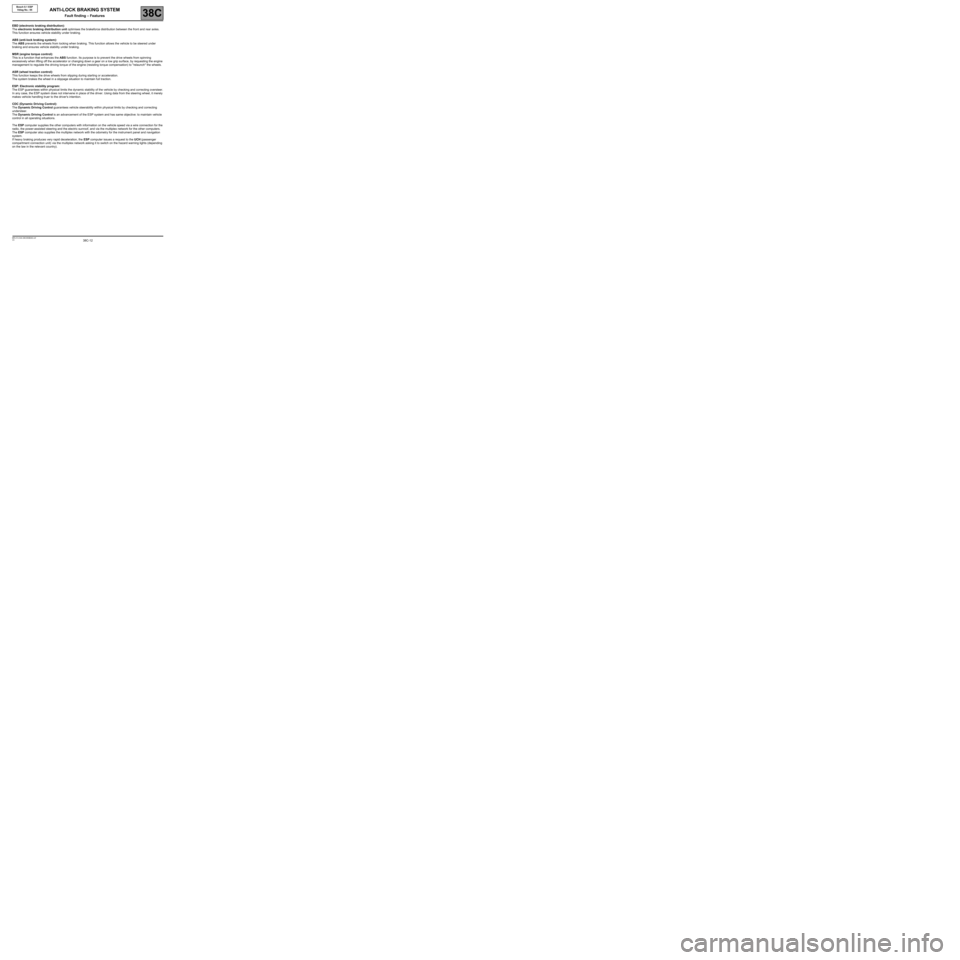
38C-12V3 MR-413-X44-38C050$040.mif
38C
Bosch 8.1 ESP
Vdiag No.: 05
EBD (electronic braking distribution):
The electronic braking distribution unit optimises the brakeforce distribution between the front and rear axles.
This function ensures vehicle stability under braking.
ABS (anti-lock braking system):
The ABS prevents the wheels from locking when braking. This function allows the vehicle to be steered under
braking and ensures vehicle stability under braking.
MSR (engine torque control):
This is a function that enhances the ABS function. Its purpose is to prevent the drive wheels from spinning
excessively when lifting off the accelerator or changing down a gear on a low grip surface, by requesting the engine
management to regulate the driving torque of the engine (resisting torque compensation) to "relaunch" the wheels.
ASR (wheel traction control):
This function keeps the drive wheels from slipping during starting or acceleration.
The system brakes the wheel in a slippage situation to maintain full traction.
ESP: Electronic stability program:
The ESP guarantees within physical limits the dynamic stability of the vehicle by checking and correcting oversteer.
In any case, the ESP system does not intervene in place of the driver. Using data from the steering wheel, it merely
makes vehicle handling truer to the driver's intention.
CDC (Dynamic Driving Control):
The Dynamic Driving Control guarantees vehicle steerability within physical limits by checking and correcting
understeer.
The Dynamic Driving Control is an advancement of the ESP system and has same objective: to maintain vehicle
control in all operating situations.
The ESP computer supplies the other computers with information on the vehicle speed via a wire connection for the
radio, the power-assisted steering and the electric sunroof, and via the multiplex network for the other computers.
The ESP computer also supplies the multiplex network with the odometry for the instrument panel and navigation
system.
If heavy braking produces very rapid deceleration, the ESP computer issues a request to the UCH (passenger
compartment connection unit) via the multiplex network asking it to switch on the hazard warning lights (depending
on the law in the relevant country).
ANTI-LOCK BRAKING SYSTEM
Fault finding – Features
Page 16 of 101
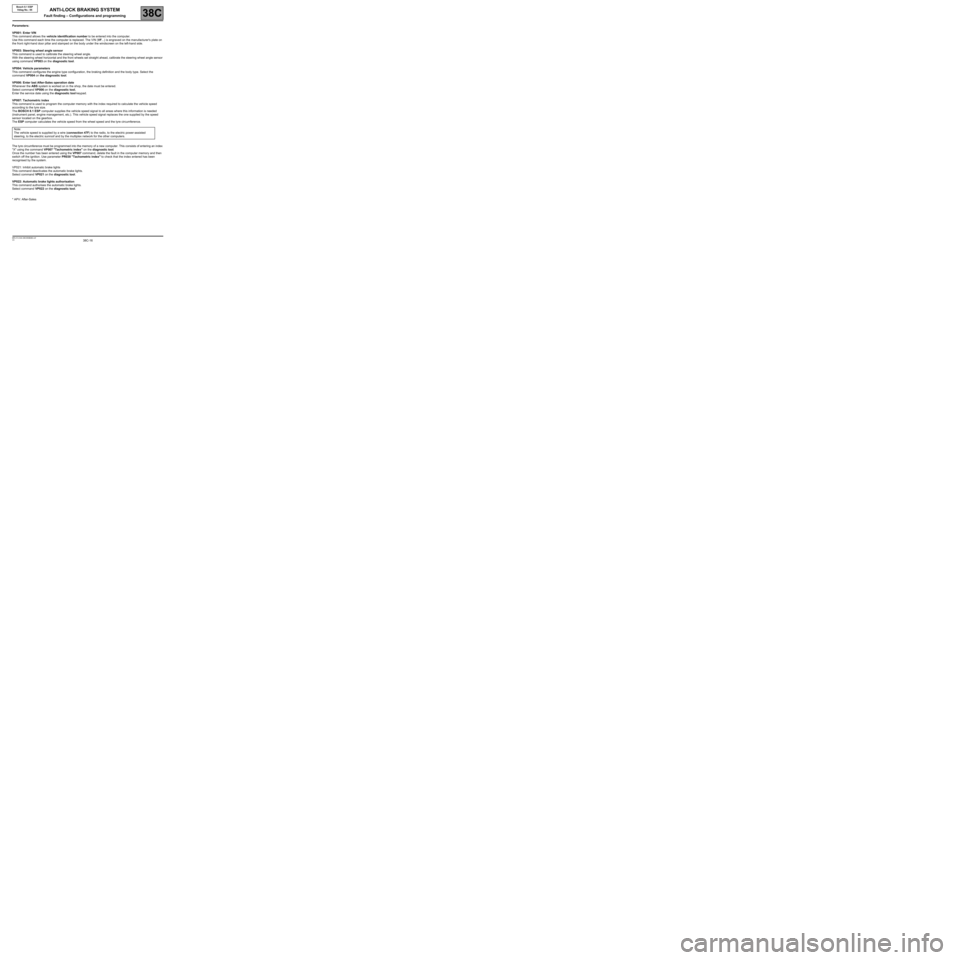
38C-16V3 MR-413-X44-38C050$080.mif
38C
Bosch 8.1 ESP
Vdiag No.: 05
Parameters:
VP001: Enter VIN
This command allows the vehicle identification number to be entered into the computer.
Use this command each time the computer is replaced. The VIN (VF...) is engraved on the manufacturer's plate on
the front right-hand door pillar and stamped on the body under the windscreen on the left-hand side.
VP003: Steering wheel angle sensor
This command is used to calibrate the steering wheel angle.
With the steering wheel horizontal and the front wheels set straight ahead, calibrate the steering wheel angle sensor
using command VP003 on the diagnostic tool.
VP004: Vehicle parameters
This command configures the engine type configuration, the braking definition and the body type. Select the
command VP004 on the diagnostic tool.
VP006: Enter last After-Sales operation date
Whenever the ABS system is worked on in the shop, the date must be entered.
Select command VP006 on the diagnostic tool.
Enter the service date using the diagnostic tool keypad.
VP007: Tachometric index
This command is used to program the computer memory with the index required to calculate the vehicle speed
according to the tyre size.
The BOSCH 8.1 ESP computer supplies the vehicle speed signal to all areas where this information is needed
(instrument panel, engine management, etc.). This vehicle speed signal replaces the one supplied by the speed
sensor located on the gearbox.
The ESP computer calculates the vehicle speed from the wheel speed and the tyre circumference.
The tyre circumference must be programmed into the memory of a new computer. This consists of entering an index
"X" using the command VP007 "Tachometric index" on the diagnostic tool.
Once the number has been entered using the VP007 command, delete the fault in the computer memory and then
switch off the ignition. Use parameter PR030 "Tachometric index" to check that the index entered has been
recognised by the system.
VP021: Inhibit automatic brake lights
This command deactivates the automatic brake lights.
Select command VP021 on the diagnostic tool.
VP022: Automatic brake lights authorisation
This command authorises the automatic brake lights.
Select command VP022 on the diagnostic tool.
* APV: After-SalesNote:
The vehicle speed is supplied by a wire (connection 47F) to the radio, to the electric power-assisted
steering, to the electric sunroof and by the multiplex network for the other computers.
ANTI-LOCK BRAKING SYSTEM
Fault finding – Configurations and programming
Page 48 of 101
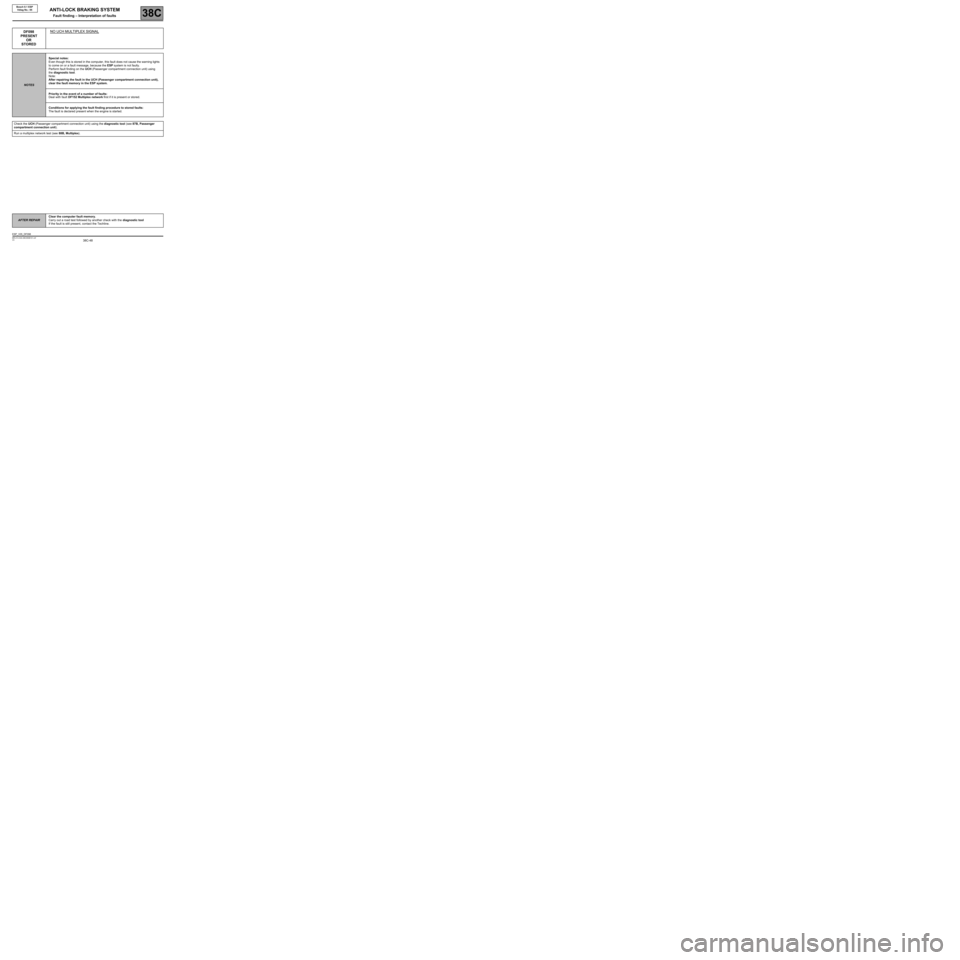
38C-48
AFTER REPAIRClear the computer fault memory.
Carry out a road test followed by another check with the diagnostic tool
If the fault is still present, contact the Techline.
V3 MR-413-X44-38C050$101.mif
ANTI-LOCK BRAKING SYSTEM
Fault finding – Interpretation of faults38C
Bosch 8.1 ESP
Vdiag No.: 05
DF098
PRESENT
OR
STOREDNO UCH MULTIPLEX SIGNAL
NOTESSpecial notes:
Even though this is stored in the computer, this fault does not cause the warning lights
to come on or a fault message, because the ESP system is not faulty.
Perform fault finding on the UCH (Passenger compartment connection unit) using
the diagnostic tool.
Note:
After repairing the fault in the UCH (Passenger compartment connection unit),
clear the fault memory in the ESP system.
Priority in the event of a number of faults:
Deal with fault DF152 Multiplex network first if it is present or stored.
Conditions for applying the fault finding procedure to stored faults:
The fault is declared present when the engine is started.
Check the UCH (Passenger compartment connection unit) using the diagnostic tool (see 87B, Passenger
compartment connection unit).
Run a multiplex network test (see 88B, Multiplex).
ESP_V05_DF098
Page 64 of 101

38C-64
AFTER REPAIRClear the computer fault memory.
Carry out a road test followed by another check with the diagnostic tool
If the fault is still present, contact the Techline.
V3 MR-413-X44-38C050$102.mif
ANTI-LOCK BRAKING SYSTEM
Fault finding – Interpretation of faults38C
Bosch 8.1 ESP
Vdiag No.: 05
DF202
PRESENT
OR
STOREDUCH MULTIPLEX SIGNALS DISABLED
DEF: Reverse gear signal consistency
NOTESSpecial notes:
Even though this is stored in the computer, this fault does not cause the warning lights
to come on or a fault message, because the ESP system is not faulty.
Perform fault finding on the UCH (Passenger compartment connection unit) using the
diagnostic tool.
Note:
After repairing the fault in the UCH (Passenger compartment connection unit), clear the
fault memory in the ESP system.
Conditions for applying the fault finding procedure to stored faults:
The fault is declared present when the engine is started.
Run a check on the UCH (Passenger compartment connection unit) using the diagnostic tool (see 87B,
Passenger compartment connection unit).
Run a multiplex network test (see 88B, Multiplex).
ESP_V05_DF202
Page 67 of 101
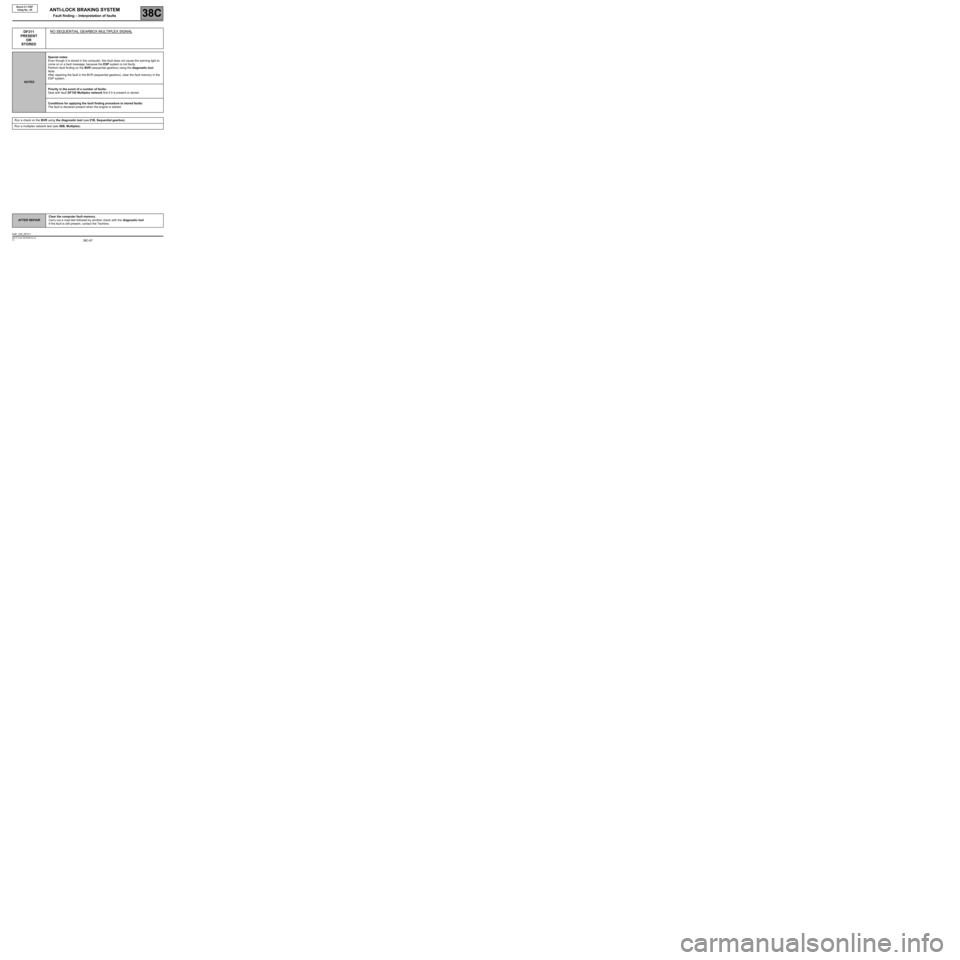
38C-67
AFTER REPAIRClear the computer fault memory.
Carry out a road test followed by another check with the diagnostic tool
If the fault is still present, contact the Techline.
V3 MR-413-X44-38C050$102.mif
ANTI-LOCK BRAKING SYSTEM
Fault finding – Interpretation of faults38C
Bosch 8.1 ESP
Vdiag No.: 05
DF311
PRESENT
OR
STOREDNO SEQUENTIAL GEARBOX MULTIPLEX SIGNAL
NOTESSpecial notes:
Even though it is stored in the computer, this fault does not cause the warning light to
come on or a fault message, because the ESP system is not faulty.
Perform fault finding on the BVR (sequential gearbox) using the diagnostic tool.
Note:
After repairing the fault in the BVR (sequential gearbox), clear the fault memory in the
ESP system.
Priority in the event of a number of faults:
Deal with fault DF152 Multiplex network first if it is present or stored.
Conditions for applying the fault finding procedure to stored faults:
The fault is declared present when the engine is started.
Run a check on the BVR using the diagnostic tool (see 21B, Sequential gearbox).
Run a multiplex network test (see 88B, Multiplex).
ESP_V05_DF311
Page 82 of 101

38C-82
AFTER REPAIRClear the computer fault memory.
Carry out a road test followed by another check with the diagnostic tool.
V3 MR-413-X44-38C050$160.mif
ANTI-LOCK BRAKING SYSTEM
Fault finding – Interpretation of commands38C
Bosch 8.1 ESP
Vdiag No.: 05
AC187BRAKE LIGHT ACTIVATION RELAY
NOTESConditions of use of the command.
Ignition on, engine off.
This command is used to test brake light activation by the ESP when controlling oversteer with sharp deceleration.
ESP_V05_AC187
Page 84 of 101
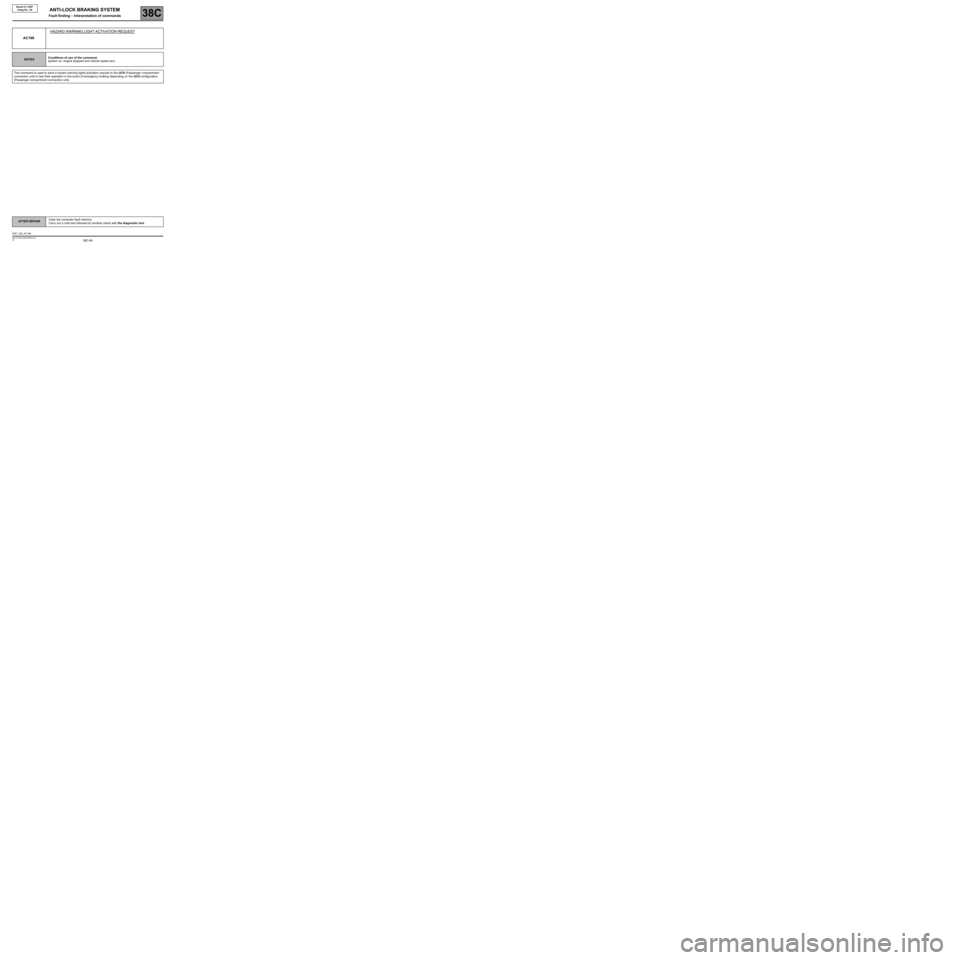
38C-84
AFTER REPAIRClear the computer fault memory.
Carry out a road test followed by another check with the diagnostic tool.
V3 MR-413-X44-38C050$160.mif
ANTI-LOCK BRAKING SYSTEM
Fault finding – Interpretation of commands38C
Bosch 8.1 ESP
Vdiag No.: 05
AC196HAZARD WARNING LIGHT ACTIVATION REQUEST
NOTESConditions of use of the command.
Ignition on, engine stopped and vehicle speed zero.
This command is used to send a hazard warning lights activation request to the UCH (Passenger compartment
connection unit) to test their operation in the event of emergency braking depending on the UCH configuration
(Passenger compartment connection unit).
ESP_V05_AC196
Page 89 of 101
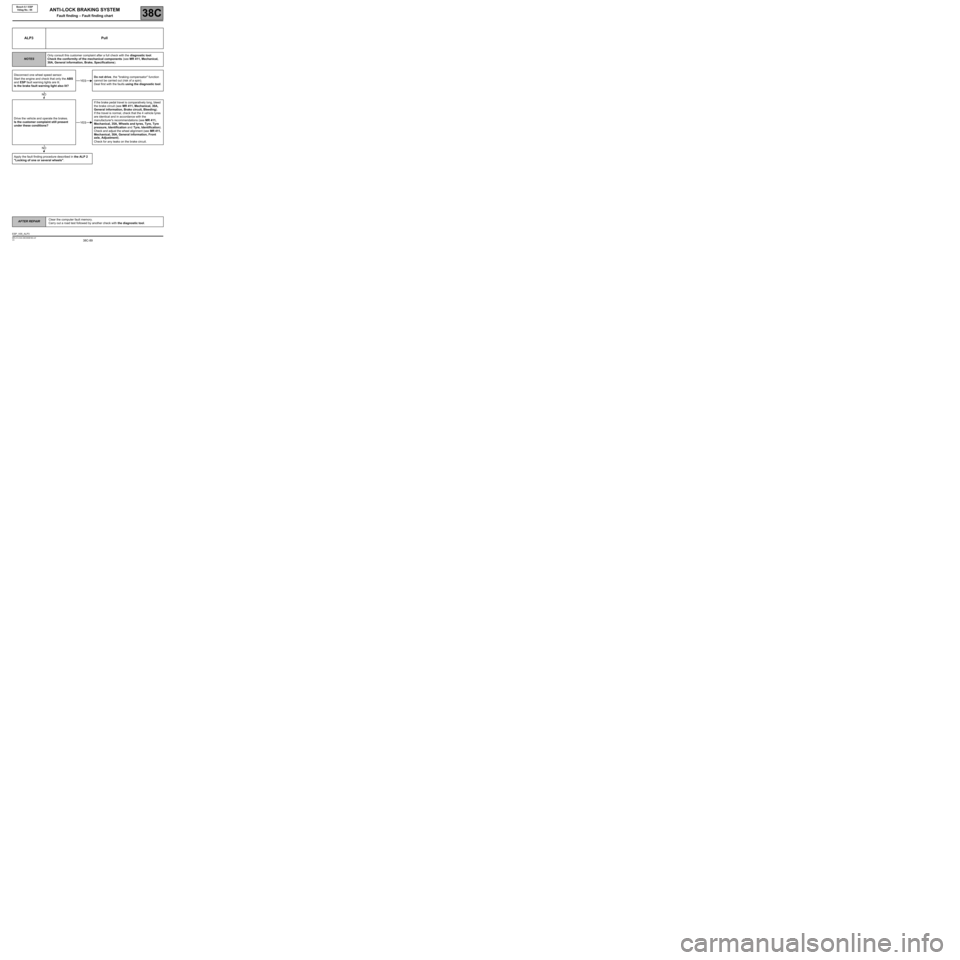
38C-89
AFTER REPAIRClear the computer fault memory.
Carry out a road test followed by another check with the diagnostic tool.
V3 MR-413-X44-38C050$180.mif
ANTI-LOCK BRAKING SYSTEM
Fault finding – Fault finding chart38C
Bosch 8.1 ESP
Vdiag No.: 05
ALP3 Pull
NOTESOnly consult this customer complaint after a full check with the diagnostic tool.
Check the conformity of the mechanical components (see MR 411, Mechanical,
30A, General information, Brake, Specifications).
Disconnect one wheel speed sensor.
Start the engine and check that only the ABS
and ESP fault warning lights are lit.
Is the brake fault warning light also lit?Do not drive, the "braking compensator" function
cannot be carried out (risk of a spin).
Deal first with the faults using the diagnostic tool.
Drive the vehicle and operate the brakes.
Is the customer complaint still present
under these conditions?If the brake pedal travel is comparatively long, bleed
the brake circuit (see MR 411, Mechanical, 30A,
General information, Brake circuit, Bleeding).
If the travel is normal, check that the 4 vehicle tyres
are identical and in accordance with the
manufacturer's recommendations (see MR 411,
Mechanical, 35A, Wheels and tyres, Tyre, Tyre
pressure, Identification and Tyre, Identification).
Check and adjust the wheel alignment (see MR 411,
Mechanical, 30A, General information, Front
axle, Adjustment).
Check for any leaks on the brake circuit.
Apply the fault finding procedure described in the ALP 2
"Locking of one or several wheels".
YES
NO
YES
NO
ESP_V05_ALP3
Page 90 of 101

38C-90
AFTER REPAIRClear the computer fault memory.
Carry out a road test followed by another check with the diagnostic tool.
V3 MR-413-X44-38C050$180.mif
ANTI-LOCK BRAKING SYSTEM
Fault finding – Fault finding chart38C
Bosch 8.1 ESP
Vdiag No.: 05
ALP4 Drift
NOTESOnly address this customer complaint after a complete check with the diagnostic tool.
Disconnect one wheel speed sensor.
Start the engine and check that only the ABS
and ESP fault warning lights are lit.
Is the brake fault warning light also lit?Do not drive, the "braking compensator" function
cannot be carried out (risk of a spin).
Deal first with the faults using the diagnostic tool.
Drive the vehicle and operate the brakes.
Is the customer complaint still present
under these conditions?It is a road holding fault not related to the ABS/ESP
system.
Check the condition and conformity of the front and
rear brake linings.
Check that the 4 vehicle tyres are identical and in
accordance with the manufacturer's
recommendations (see MR 411, Mechanical, 35A,
Wheels and tyres, Tyre pressure, Identification
and Tyres, Identification).
Check that the pressures of the 4 tyres conform to
the manufacturer's recommendations (see MR 411,
Mechanical, 35A, Wheels and tyres, Tyre
pressure, Identification).
Check and adjust the wheel alignment (see MR 411,
Mechanical, 30A, General information, Front
axle, Adjustment).
Normal behaviour linked to the system operation during the
regulation phase, mainly on surfaces with uneven grip or
which are poorly laid.
YES
NO
YES
NO
ESP_V05_ALP4